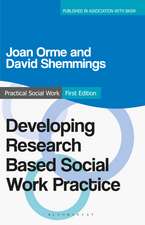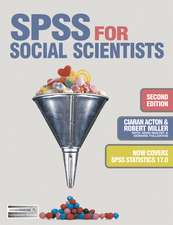Social Research: A Practical Introduction
Autor Bruce Curtis, Cate Curtisen Limba Engleză Paperback – 14 noi 2011
Explicitly addressing the concerns of emergent researchers it provides both a 'how to' account of social research and an understanding of the main factors that contextualize research by discussing 'why do' social scientists work this way.
Throughout the twelve comprehensive chapters procedural (how to) accounts and contextual (why do) issues are usefully applied to major themes and substantive questions.
These key themes include:
(1) Research design
(2) The practices of research and emergent researchers: Beyond ontology, epistemology and methodology
(3) The impact of technology on research
(4) Putting the research approach in context.
A superb teaching text this book will be relished by lecturers seeking an authoritative introduction to social research and by students who want an accessible, enriching text to guide and inspire them.
Preț: 411.68 lei
Preț vechi: 484.33 lei
-15%
Puncte Express: 618
Preț estimativ în valută:
72.91€ • 85.15$ • 63.33£
72.91€ • 85.15$ • 63.33£
Carte tipărită la comandă
Livrare economică 21 februarie-07 martie
Preluare comenzi: 021 569.72.76
Specificații
ISBN-13: 9781847874757
ISBN-10: 1847874754
Pagini: 312
Dimensiuni: 186 x 232 x 27 mm
Greutate: 0.48 kg
Ediția:1
Editura: SAGE Publications
Colecția Sage Publications Ltd
Locul publicării:London, United Kingdom
ISBN-10: 1847874754
Pagini: 312
Dimensiuni: 186 x 232 x 27 mm
Greutate: 0.48 kg
Ediția:1
Editura: SAGE Publications
Colecția Sage Publications Ltd
Locul publicării:London, United Kingdom
Recenzii
Finally a Social Research textbook that provides a clear and comprehensive introduction to the field, one that considers the origins of approaches and addresses epistemological and ethical contexts, and offers thoughtful discussion of and practical guidance on both quantitative and qualitative methods. This book will prove to be an invaluable resource for students and teachers and deserves to become the benchmark for texts in the field
Barry Smart
Professor of Sociology, University of Portsmouth
This book does an important job in providing an excellent methods textbook which is organized around Charles Ragin's distinction between case and variable centred methods and draws explicitly on the social realist frame of reference in presenting arguments and instruction. Those of us who teach undergraduates on research methods courses now have available a textbook which in an accessible way takes students through the repertoire of social research approaches drawing on the most innovative ways of thinking about what social research is trying to achieve
Professor David Byrne
School of Applied Social Sciences, Durham University
This is an ambitious book that delivers the goods. It provides a comprehensive overview of a wide range of the main approaches to social science research. It avoids the simplistic quantitative/qualitative divide and provides a useful way of thinking about the various research approaches. It achieves that difficult balance between a practical, how-to book and one which provides a deeper understanding of what the research approaches are doing. The breadth provided in this book will enable researchers to wisely chose between research approaches according to the nature of the problem and the understanding they seek to achieve
Professor David de Vaus
Executive Dean, Faculty of Social and Behavioural Sciences, University of Queensland
Barry Smart
Professor of Sociology, University of Portsmouth
This book does an important job in providing an excellent methods textbook which is organized around Charles Ragin's distinction between case and variable centred methods and draws explicitly on the social realist frame of reference in presenting arguments and instruction. Those of us who teach undergraduates on research methods courses now have available a textbook which in an accessible way takes students through the repertoire of social research approaches drawing on the most innovative ways of thinking about what social research is trying to achieve
Professor David Byrne
School of Applied Social Sciences, Durham University
This is an ambitious book that delivers the goods. It provides a comprehensive overview of a wide range of the main approaches to social science research. It avoids the simplistic quantitative/qualitative divide and provides a useful way of thinking about the various research approaches. It achieves that difficult balance between a practical, how-to book and one which provides a deeper understanding of what the research approaches are doing. The breadth provided in this book will enable researchers to wisely chose between research approaches according to the nature of the problem and the understanding they seek to achieve
Professor David de Vaus
Executive Dean, Faculty of Social and Behavioural Sciences, University of Queensland
Cuprins
PART ONE: INTRODUCTION
Doing data collection and analysis
Origins of the approach
Structure of the book
Case-centric or variable-centric research
Analytical induction or hypothesis-testing
Some issues in research
Epistemology
Reliability and validity
Ethical considerations
Ethical issues: Risk of harm
Averting/Dealing with discomfort
Ethical issues: Deception
Ethical issues: Debriefing
Ethical issues: Where to from here?
Putting the approach in context
Fixed or fluid framings or research
Precursors to research
Developing the research topic
Preparing a research proposal
Recruitment of participants
Conclusion
Further readings
References
PART TWO: IN-DEPTH INTERVIEWING - THE INTERACTIVE BASE
Doing data collection, analysis and presentation
What is an in-depth interview?
How is an in-depth interview different from a questionnaire-based interview?
How is an interview different from a focus group?
How is an interview different from a discussion?
Origins of the approach
The practicalities: What are the advantages of in-depth interviews?
What are the disadvantages?
Preparing and undertaking a 'typical' set of interviews
Developing the research topic
Ethics approval
Developing the interview guide
Sampling and recruitment of participants
Collection of data: Beginning the interview
Collection of data: During the interview
Non-verbal cues and body language
Collection of data: Completing the interview
Debriefing
Data management
Transcribing
Journaling
Analysis of data
Analytical induction
Grounded theory and thematic analysis
Some issues in research
Interviews as data sources and data-creators
Epistemological concerns and constraints
Resource issues
Putting the approach in context
Visual techniques: Photo-elicitation and photo-voice
Computer-based data analysis
Conclusion
Further readings
References
PART THREE: LIFE HISTORIES - PRIVATE TROUBLES AND PUBLIC ISSUES
Doing data collection and analysis
Origins of the approach
Life history research cf. oral history
Pointers in doing a life history
Building rapport
Memory and recall
Analytical induction
Triangulation
Naturalistic and edited forms of life history
Some issues in research
Epistemology and claims for validity and reliability
Putting the approach in context
Conclusion
Further readings
References
PART FOUR: ETHNOGRAPHIC RESEARCH - STUDYING GROUPS IN NATURAL SETTINGS
Doing data collection, analysis and presentation
Origins of the approach
Data collection
Entering the field
Observation in practice
Exiting the field
Data analysis and presentation
Some issues in research
Epistemology and claims for validity and reliability
Resource limitations
Putting the approach in context
The impacts of new technologies on ethnography
The ethics of ethnography
Conclusion
Further readings
References
PART FIVE: FOCUS GROUPS - STUDYING ARTIFICIAL GROUPS
Doing data collection and analysis
Exceptional focus groups
Origins of the approach
Data collection
Some issues in research
Epistemology
Reliability and validity
Putting the approach in context
A real-life example: When focus groups go wrong
Conclusion
Further readings
References
PART SIX: SURVEY RESEARCH - STUDYING MANY CASES
Doing data collection and analysis
Origins of the approach
Hypothesis-testing: From insights to posing questions
Attributes, attitudes and behaviour
Sample size and margin of error
Response rates
Sampling strategies
Scales of measurement
Statistical analysis: Hypothesis-testing and the null hypothesis
Some issues in research
Epistemology and scales of measurement
Question formats
Putting the approach in context
Survey fatigue and oversampling
Conclusion
Further readings
References
PART SEVEN: EXPERIMENTAL RESEARCH - IN THE LABORATORY AND BEYOND
Doing data collection and analysis
Origins of the approach
Hypothesis-testing
Variables in experiments
Validity and reliability in data collection
Cases in experiments
Analyzing experiments
Some issues in research
Ethical issues
The crisis in social psychology: A crisis in positivist epistemology?
Resourcing
Putting the approach in context
Conclusion
Further readings
References
PART EIGHT: UNOBTRUSIVE RESEARCH - STUDYING ARTEFACTS AND MATERIAL TRACES
Doing data collection and analysis
Origins of the approach
Applications of unobtrusive methods
Examples of unobtrusive research
Some issues in research
Methodological issues: Observer bias
Methodological issues: Bias within the data
Ethical issues: Defining 'unobtrusive'
Ethical issues: Informed consent
Ethical issues: Deception
Ethical issues: Debriefing
Ethical issues: Where to from here?
Putting the approach in context
The use of new technologies
Conclusion
Further readings
References
PART NINE: CONTENT RESEARCH - CODING AND COUNTING
Doing data collection and analysis
Origins of the approach
Looking at coding form
Hypothesis-testing
Deciding on what is a case
Coding: Develop a codebook, design a coding form, train the coders
Drawing a sample
Some issues in research
Epistemology and claims for validity and reliability
Putting the approach in context
Conclusion
Further readings
References
PART TEN: SECONDARY RESEARCH - MORE THAN LITERATURE REVIEWS
Doing data collection and analysis
Origins of the approach
Search engines
Boolean searches
Hypothesis-testing
Secondary versus primary research
Finding gaps in, and running with or against the literature
Meta-analyses: combining and testing results
Some issues in research
Epistemology and goals of social research
Putting the approach in context
Issues in quality assurance
Conclusion
Further readings
References
PART ELEVEN: SEMIOTIC ANALYSIS - STUDYING SIGNS AND MEANINGS
Doing data collection and analysis
Origins of the approach
Analysing signs
Some issues in research
An aside on rigour
Structuralism and post-structuralism
Putting the approach in context
Conclusion
Further readings
PART TWELVE: AUTOETHNOGRAPHIC RESEARCH - WRITING AND READING THE SELF
Doing data collection and analysis
An authoethnographic aside
Origins of the approach
Autobiography and reflexivity as a case
Data collection and analysis and reflexivity
Guidelines for writers
Analytical autoethnography
Aims of autoethnography
Some issues in research
Epistemology and claims for validity and reliability
Evaluating autoethnographies
Putting the approach in context
Motivations: The forms of personal documents
Conclusion
Further readings
References
Glossary
Doing data collection and analysis
Origins of the approach
Structure of the book
Case-centric or variable-centric research
Analytical induction or hypothesis-testing
Some issues in research
Epistemology
Reliability and validity
Ethical considerations
Ethical issues: Risk of harm
Averting/Dealing with discomfort
Ethical issues: Deception
Ethical issues: Debriefing
Ethical issues: Where to from here?
Putting the approach in context
Fixed or fluid framings or research
Precursors to research
Developing the research topic
Preparing a research proposal
Recruitment of participants
Conclusion
Further readings
References
PART TWO: IN-DEPTH INTERVIEWING - THE INTERACTIVE BASE
Doing data collection, analysis and presentation
What is an in-depth interview?
How is an in-depth interview different from a questionnaire-based interview?
How is an interview different from a focus group?
How is an interview different from a discussion?
Origins of the approach
The practicalities: What are the advantages of in-depth interviews?
What are the disadvantages?
Preparing and undertaking a 'typical' set of interviews
Developing the research topic
Ethics approval
Developing the interview guide
Sampling and recruitment of participants
Collection of data: Beginning the interview
Collection of data: During the interview
Non-verbal cues and body language
Collection of data: Completing the interview
Debriefing
Data management
Transcribing
Journaling
Analysis of data
Analytical induction
Grounded theory and thematic analysis
Some issues in research
Interviews as data sources and data-creators
Epistemological concerns and constraints
Resource issues
Putting the approach in context
Visual techniques: Photo-elicitation and photo-voice
Computer-based data analysis
Conclusion
Further readings
References
PART THREE: LIFE HISTORIES - PRIVATE TROUBLES AND PUBLIC ISSUES
Doing data collection and analysis
Origins of the approach
Life history research cf. oral history
Pointers in doing a life history
Building rapport
Memory and recall
Analytical induction
Triangulation
Naturalistic and edited forms of life history
Some issues in research
Epistemology and claims for validity and reliability
Putting the approach in context
Conclusion
Further readings
References
PART FOUR: ETHNOGRAPHIC RESEARCH - STUDYING GROUPS IN NATURAL SETTINGS
Doing data collection, analysis and presentation
Origins of the approach
Data collection
Entering the field
Observation in practice
Exiting the field
Data analysis and presentation
Some issues in research
Epistemology and claims for validity and reliability
Resource limitations
Putting the approach in context
The impacts of new technologies on ethnography
The ethics of ethnography
Conclusion
Further readings
References
PART FIVE: FOCUS GROUPS - STUDYING ARTIFICIAL GROUPS
Doing data collection and analysis
Exceptional focus groups
Origins of the approach
Data collection
Some issues in research
Epistemology
Reliability and validity
Putting the approach in context
A real-life example: When focus groups go wrong
Conclusion
Further readings
References
PART SIX: SURVEY RESEARCH - STUDYING MANY CASES
Doing data collection and analysis
Origins of the approach
Hypothesis-testing: From insights to posing questions
Attributes, attitudes and behaviour
Sample size and margin of error
Response rates
Sampling strategies
Scales of measurement
Statistical analysis: Hypothesis-testing and the null hypothesis
Some issues in research
Epistemology and scales of measurement
Question formats
Putting the approach in context
Survey fatigue and oversampling
Conclusion
Further readings
References
PART SEVEN: EXPERIMENTAL RESEARCH - IN THE LABORATORY AND BEYOND
Doing data collection and analysis
Origins of the approach
Hypothesis-testing
Variables in experiments
Validity and reliability in data collection
Cases in experiments
Analyzing experiments
Some issues in research
Ethical issues
The crisis in social psychology: A crisis in positivist epistemology?
Resourcing
Putting the approach in context
Conclusion
Further readings
References
PART EIGHT: UNOBTRUSIVE RESEARCH - STUDYING ARTEFACTS AND MATERIAL TRACES
Doing data collection and analysis
Origins of the approach
Applications of unobtrusive methods
Examples of unobtrusive research
Some issues in research
Methodological issues: Observer bias
Methodological issues: Bias within the data
Ethical issues: Defining 'unobtrusive'
Ethical issues: Informed consent
Ethical issues: Deception
Ethical issues: Debriefing
Ethical issues: Where to from here?
Putting the approach in context
The use of new technologies
Conclusion
Further readings
References
PART NINE: CONTENT RESEARCH - CODING AND COUNTING
Doing data collection and analysis
Origins of the approach
Looking at coding form
Hypothesis-testing
Deciding on what is a case
Coding: Develop a codebook, design a coding form, train the coders
Drawing a sample
Some issues in research
Epistemology and claims for validity and reliability
Putting the approach in context
Conclusion
Further readings
References
PART TEN: SECONDARY RESEARCH - MORE THAN LITERATURE REVIEWS
Doing data collection and analysis
Origins of the approach
Search engines
Boolean searches
Hypothesis-testing
Secondary versus primary research
Finding gaps in, and running with or against the literature
Meta-analyses: combining and testing results
Some issues in research
Epistemology and goals of social research
Putting the approach in context
Issues in quality assurance
Conclusion
Further readings
References
PART ELEVEN: SEMIOTIC ANALYSIS - STUDYING SIGNS AND MEANINGS
Doing data collection and analysis
Origins of the approach
Analysing signs
Some issues in research
An aside on rigour
Structuralism and post-structuralism
Putting the approach in context
Conclusion
Further readings
PART TWELVE: AUTOETHNOGRAPHIC RESEARCH - WRITING AND READING THE SELF
Doing data collection and analysis
An authoethnographic aside
Origins of the approach
Autobiography and reflexivity as a case
Data collection and analysis and reflexivity
Guidelines for writers
Analytical autoethnography
Aims of autoethnography
Some issues in research
Epistemology and claims for validity and reliability
Evaluating autoethnographies
Putting the approach in context
Motivations: The forms of personal documents
Conclusion
Further readings
References
Glossary
Notă biografică
Bruce Curtis teaches sociology. His research interests include how policies, technologies and local and international markets impact organizations and methodology.
Descriere
An accessible, multidisciplinary introduction to a wide range of social research methods. With a coherent mixed methods approach to each of the core methods in social research it reflects real world practice and contextual perspectives.









